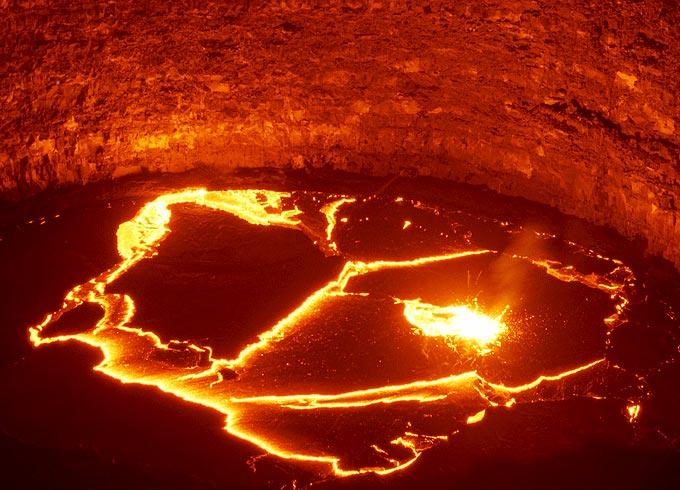Part of the duties of my new job is some lecturing on behalf of my supervisor (now boss, I suppose). I'm finding this a bit daunting, even if I have been given Powerpoint presentations for each lecture; this means at least I don't have to compile things from scratch, although it does take a while to remove all the instances of text zooming in with a swooshing sound (another crime against humanity perpetrated by Microsoft).
My first lecture started with a discussion of why we have tectonic plates, and I got to present a really cool example of a situation where similar processes are occurring over timescales much easier for us to grasp conceptually. All the pictures in this post come from a lava lake in the crater of Erte Arle volcano in Ethiopia. You get lots of the sorts of activity you’d associate with such an environment (such as fountain eruptions and bubbling molten lava), all occurring as the lava is heated from below and the hotter, less dense, material forces its way to the surface. However, what's even more interesting is that a lot of the time the surface of the lake is formed by a solid crust of cooled magma. Vigorous convection is still occurring beneath this crust, and in response to this the crust breaks up into a number of discrete slabs.
Sound familiar? The relationship between the lava crust and the convecting molten lava beneath it is precisely the same as that between the lithosphere and the asthenosphere - the convecting and non-convecting parts of the Earth's mantle. In both cases the boundary is controlled not by composition but by temperature - contact with the air has cooled the upper part of the lava lake so that it solidifies and begins to act rigidly; heat loss through the Earth's surface causes the same thing to happen to the upper 100 km or so of the mantle.
The internal strength of the lava 'plates' compared to the molten material beneath them causes them to move coherently over the surface of the crater, with little frictional drag at their base to slow them down, or dissipate any forces which are applied to them. In such a situation the forces exerted at the boundaries of the slabs become particularly important. Again, the same situation seems to apply for the tectonic plates on the Earth's surface, so it is no surprise that you can see analogues of different types of tectonic plate boundaries at the borders of the lava slabs. Here's a rift zone, where two slabs are moving apart:
The orange crack shows where lava is welling up to the surface of the lake. It cools and solidifies and is itself pushed away from the rift by yet more upwelling magma. Notice the symmetrical pattern of light and dark grey bands moving away from the crack - this is caused by slight variations in the composition of the upwelling magma over time (and is very reminiscent of the striped magnetic anomalies seen either side of a mid-ocean ridge).
The force pushing the slabs apart at this boundary will be transmitted to the opposite boundaries of the two slabs, where they will be pushed against their neighbours. In such a situation one plate is forced beneath the other, forming a 'subduction zone' (in the picture below, the lava slab is being pushed against the crater wall, but the principle remains the the same):
The best thing about this example, though, is that molten lava has a much lower viscosity than asthenospheric mantle, flowing at centimetres per second rather than centimetres per year. This means that you can see the equivalent of hundreds of millions of years of tectonic processes occurring in the space of a few hours. This movie (Quicktime) was created using time-lapse photography: as evening draws in, plates on the surface of the lava lake are created and die, move apart and push together. It's really cool. Watch it.
30 November, 2005
Lava lake tectonics
Subscribe to:
Post Comments (Atom)




No comments:
Post a Comment